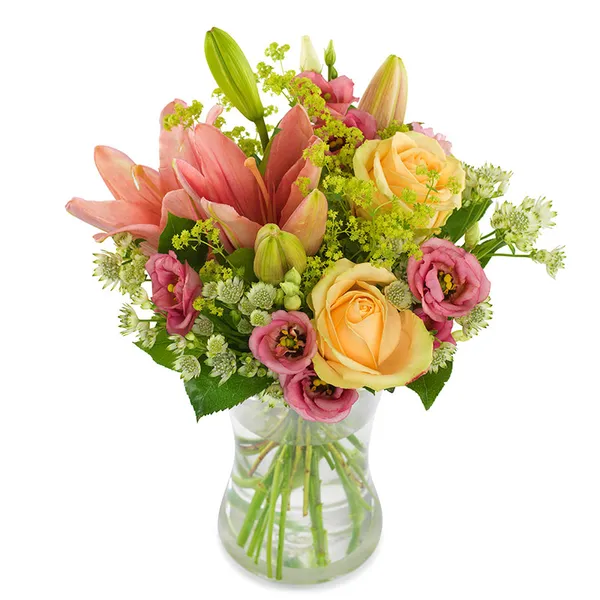Daffodils: The bright and cheerful symbol of spring
Daffodils are iconic spring flowers known for their bright yellow or white trumpet-shaped blooms that signal the arrival of warmer days. They symbolise renewal, hope, and prosperity, making them a popular feature in spring celebrations and Easter arrangements. Originally from Europe and North Africa, daffodils are easy to grow and appreciated for their ability to naturalise and return year after year. Their cheerful appearance and vibrant colours make them a spring favourite for gardens, flower bouquets, and seasonal decorations. Daffodils are especially popular during Easter.
COMMON NAME
Daffodil
BOTANICAL NAME
Narcissus spp.
ORIGIN
Europe and North Africa
PEOPLE ALSO CALL IT
Jonquil, Narcissus, Lent Lily
FLOWERING TIME
Early to late spring (March to May)
ASPECT
Full sun to partial shade
SYMBOLISM
Renewal, hope, prosperity, rebirth
Care Tips for a Cut Daffodils in a Vase
Handle Separately: Daffodils release a sap that can be harmful to other flowers. Allow them to sit in water alone for a few hours before mixing with other blooms.
Trim Stems: Re-cut the stems diagonally before placing them in fresh water.
Use Fresh Water: Replace the water daily to keep the flowers hydrated and prevent sap buildup.
Avoid Heat and Direct Sunlight: Place the vase in a cool area away from direct sunlight and drafts.
Separate from Ethylene Sources: Keep daffodils away from ripening fruits, which release ethylene gas and can shorten their lifespan.
Symbolism & Meaning
Daffodils are powerful symbols of renewal and hope, often associated with spring and new beginnings. Their bright yellow blooms are linked to happiness and optimism, while white daffodils signify purity. In some cultures, they are a symbol of prosperity and good fortune, believed to bring blessings when seen blooming in the spring. Daffodils are also the national flower of Wales and are often associated with St. David's Day.
Types of Daffodils
Daffodils come in a variety of forms, with Trumpet Daffodils being the most recognisable, featuring a long central trumpet surrounded by six petals. Double Daffodils have layers of petals for a fuller, more dramatic appearance. Miniature Daffodils, such as 'Tête-à-Tête', are smaller and ideal for pots and compact spaces. Split-Corona Daffodils have ruffled, open trumpets that give a unique, frilly look. With their diversity in size, shape, and colour, daffodils offer endless options for adding cheer to gardens or make for a beautiful daffodil flower bouquet.
Frequently Asked Questions About Daffodils
Plant daffodil bulbs in autumn (September to November), around 6-8 weeks before the first frost. This allows the bulbs to establish roots before winter.
Choose a sunny or partially shaded location with well-draining soil.
Dig holes 10-15 cm deep and space the bulbs about 7-15 cm apart.
Place the bulbs pointed side up and cover them with soil. Water thoroughly after planting.
- Sketch the Outline: Start with a small oval for the trumpet (centre part) and a larger circle around it to guide petal placement.
- Draw the Trumpet: Add detail to the oval by extending its edges into a ruffled, funnel-like shape.
- Add Petals: Draw six elongated, pointed petals around the centre, evenly spaced.
- Refine Details: Add veins on the petals and texture on the trumpet for realism.
- Draw the Stem and Leaves: Extend a long, straight stem downward and add narrow, arching leaves.
- Shade or Colour: Use yellow for the petals, orange for the trumpet, and green for the stem and leaves.
This is what you should do with your daffodil bulb when they finish flowering:
- Deadhead: Remove remaining flowers to prevent seed production but leave the foliage intact.
- Allow Foliage to Die Back: Continue watering and feeding the plant until the leaves turn yellow and die back naturally.
- Storage or Replanting:
- If keeping in pots, move the pot to a cool, shaded location.
- If replanting, transfer the bulbs to a garden bed or store them until the next planting season.
Autumn (September to November): Plant bulbs in pots during the same period as in the garden to allow them to root before winter. Use well-draining potting mix and plant the bulbs at a depth of 10-15 cm. Place the pot in a sunny, frost-free location.
- After Lifting: Dig up bulbs after the foliage has died back completely (usually late spring or early summer).
- Clean and Dry: Brush off soil and remove any damaged or diseased bulbs. Allow them to air dry in a cool, shaded spot for a few days.
- Storage: Store bulbs in a breathable container (like a mesh bag or box) with dry peat moss or sawdust to prevent moisture buildup. Keep them in a cool, dark, and dry place until autumn planting.
It could be that your daffodils are being eaten by vermin.
Common vermin include:
- Slugs and Snails: These pests chew on the petals, especially during damp weather.
- Deer and Rabbits: Although daffodils are generally toxic and avoided, hungry animals might nibble on them.
- Insects: Thrips or bulb flies may damage daffodil flowers, though they primarily target the bulbs or stems.
Prevention Tips:
- Use slug and snail traps or barriers.
- Spray plants with animal repellents.
- Inspect regularly for signs of insect infestations and treat with appropriate insecticides if needed.
